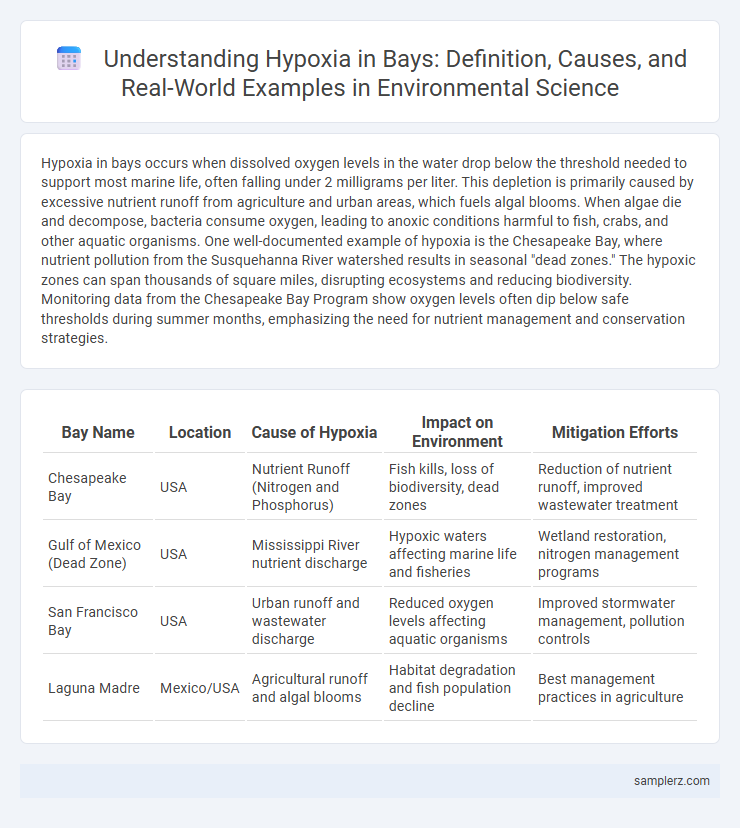Hypoxia in bays occurs when dissolved oxygen levels in the water drop below the threshold needed to support most marine life, often falling under 2 milligrams per liter. This depletion is primarily caused by excessive nutrient runoff from agriculture and urban areas, which fuels algal blooms. When algae die and decompose, bacteria consume oxygen, leading to anoxic conditions harmful to fish, crabs, and other aquatic organisms. One well-documented example of hypoxia is the Chesapeake Bay, where nutrient pollution from the Susquehanna River watershed results in seasonal "dead zones." The hypoxic zones can span thousands of square miles, disrupting ecosystems and reducing biodiversity. Monitoring data from the Chesapeake Bay Program show oxygen levels often dip below safe thresholds during summer months, emphasizing the need for nutrient management and conservation strategies.
Table of Comparison
| Bay Name | Location | Cause of Hypoxia | Impact on Environment | Mitigation Efforts |
|---|---|---|---|---|
| Chesapeake Bay | USA | Nutrient Runoff (Nitrogen and Phosphorus) | Fish kills, loss of biodiversity, dead zones | Reduction of nutrient runoff, improved wastewater treatment |
| Gulf of Mexico (Dead Zone) | USA | Mississippi River nutrient discharge | Hypoxic waters affecting marine life and fisheries | Wetland restoration, nitrogen management programs |
| San Francisco Bay | USA | Urban runoff and wastewater discharge | Reduced oxygen levels affecting aquatic organisms | Improved stormwater management, pollution controls |
| Laguna Madre | Mexico/USA | Agricultural runoff and algal blooms | Habitat degradation and fish population decline | Best management practices in agriculture |
Understanding Hypoxia in Bays
Hypoxia in bays occurs when dissolved oxygen levels fall below 2 mg/L, often due to nutrient pollution from agricultural runoff causing algal blooms that deplete oxygen during decomposition. Chesapeake Bay frequently experiences hypoxic zones, especially in summer, impacting aquatic life such as blue crabs and striped bass. Monitoring oxygen levels and reducing nitrogen and phosphorus inputs are critical steps for managing hypoxia and restoring bay ecosystems.
Causes of Hypoxia in Coastal Environments
Nutrient runoff from agriculture and wastewater discharge increases nitrogen and phosphorus levels in coastal bays, promoting excessive algal blooms that deplete oxygen when they decompose. Warm water temperatures reduce oxygen solubility, exacerbating hypoxic conditions. Limited water circulation and stratification further prevent oxygen replenishment, intensifying dead zones in bays like the Gulf of Mexico and Chesapeake Bay.
Notable Examples of Bay Hypoxia Worldwide
The Gulf of Mexico Dead Zone exemplifies severe bay hypoxia, where nutrient runoff from the Mississippi River causes oxygen depletion, critically affecting marine life. Chesapeake Bay experiences persistent hypoxic zones annually due to excess nitrogen and phosphorus from agricultural and urban sources, disrupting fish populations and underwater habitats. Similarly, the Baltic Sea's shallow bays suffer from extensive hypoxia driven by eutrophication, threatening biodiversity and fisheries in the region.
Effects of Hypoxia on Marine Ecosystems
Hypoxia in bays significantly disrupts marine ecosystems by depleting oxygen levels crucial for aquatic life survival. Low oxygen conditions lead to massive fish kills, reduced biodiversity, and altered species composition, forcing sensitive organisms to migrate or perish. These changes destabilize food webs, impairing ecosystem services like nutrient cycling and fisheries productivity.
Seasonal Variations of Hypoxia in Bays
Seasonal variations of hypoxia in bays often result from temperature-driven stratification, which reduces oxygen exchange between surface and bottom waters during summer months. In Chesapeake Bay, hypoxic zones typically expand in late summer due to increased nutrient runoff and higher water temperatures that enhance microbial oxygen consumption. This seasonal pattern leads to recurring bottom-water oxygen depletion, severely impacting aquatic life and ecosystem health.
Gulf of Mexico Dead Zone: A Case Study
The Gulf of Mexico Dead Zone, spanning up to 6,000 square miles annually, exemplifies hypoxia caused by nutrient pollution, primarily from agricultural runoff containing excess nitrogen and phosphorus. This nutrient overload fuels massive algal blooms that deplete oxygen in the water, creating uninhabitable conditions for marine life and disrupting commercial fisheries. Monitoring by NOAA highlights the correlation between Mississippi River discharge and the Dead Zone's size, emphasizing the impact of upstream land use on coastal water quality.
Chesapeake Bay Hypoxia Events
Chesapeake Bay experiences frequent hypoxia events primarily due to nutrient pollution from agricultural runoff and urban wastewater, which stimulate excessive algal blooms. When these algae die and decompose, oxygen levels in the bottom waters drop sharply, creating dead zones that threaten aquatic life such as blue crabs and striped bass. Seasonal monitoring reveals that hypoxic conditions typically peak during summer months, significantly impacting the bay's biodiversity and fisheries.
Human Activities Leading to Hypoxic Conditions
Nutrient runoff from agricultural fertilizers and untreated sewage discharge significantly increase nitrogen and phosphorus levels in bays, promoting excessive algal blooms and subsequent oxygen depletion. Industrial effluents and urban stormwater contribute to organic matter loading, intensifying microbial respiration that consumes dissolved oxygen. Coastal development disrupts natural water circulation, exacerbating hypoxic zones and threatening marine ecosystems.
Monitoring and Predicting Bay Hypoxia
Monitoring bay hypoxia involves using real-time sensors to measure dissolved oxygen levels, water temperature, and salinity, providing critical data for early detection of low-oxygen zones. Predictive models integrate historical hypoxia patterns, nutrient load data, and meteorological conditions to forecast the timing and extent of hypoxic events in bays like the Chesapeake Bay. Effective monitoring and prediction help manage nutrient inputs and guide mitigation efforts to preserve aquatic ecosystems and fisheries.
Solutions and Restoration Efforts for Hypoxic Bays
Restoration efforts for hypoxic bays prioritize reducing nutrient pollution through improved agricultural practices and wastewater treatment upgrades that limit nitrogen and phosphorus runoff. Implementing oyster reef restoration and seagrass bed reestablishment enhances oxygen levels by promoting natural filtration and habitat complexity. Monitoring programs combined with adaptive management strategies track water quality improvements, guiding targeted interventions to mitigate hypoxia effectively.

example of hypoxia in bay Infographic
 samplerz.com
samplerz.com